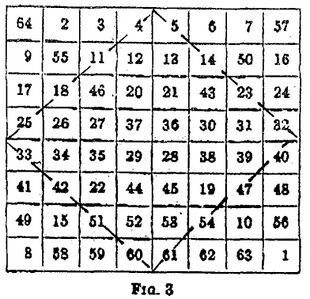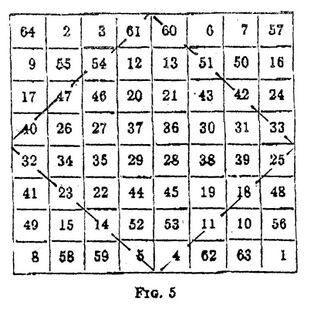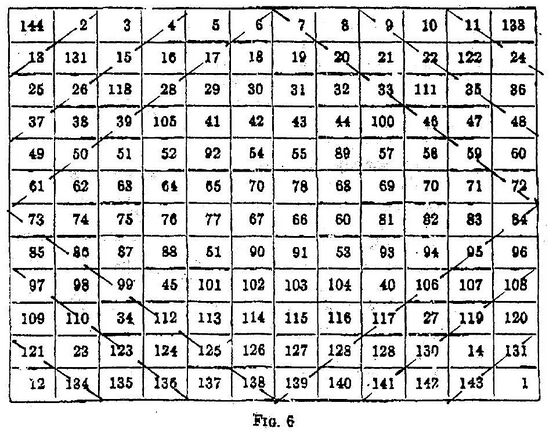Mystic square
The square array of the integers 1 through n2 that is generated when a method for constructing a 4 × 4 magic square is generalized was called a mystic square by Joel B. Wolowelsky and David Shakow in their article describing a method for constructing a magic square whose order is a multiple of 4.[1] A 4 × 4 magic square can be constructed by writing out the numbers from 1 to 16 consecutively in a 4 × 4 matrix and then interchanging those numbers on the diagonals that are equidistant from the center. (Figure 1). The sum of each row, column and diagonal is 34, the “magic number” for a 4 × 4 magic square. In general, the “magic number” for an n × n magic square is n(n^2 + 1)/2.
Properties of a mystic square
As seen in the example for a 6 × 6 square (Figure 2), the properties of the mystic square are related to those of a 6 × 6 magic square. The sum of the diagonals is 111, the magic number for a 6 × 6 magic square. The sums of the rows increase arithmetically with a common difference of 12 and an average of 111. The columns also increase arithmetically with a common difference of 2 and an average of 111. The quotient of the two common differences is 6. This pattern proves true for all values of n. For the special case of n = 4 (where the mystic square is already a magic square), the quotient of the common differences is the indeterminate 0/0, which may be assigned the value 4 for consistency.
Converting an n × n mystic square to a magic square when n is a multiple of 4
As illustrated in the case where n = 8, the method consists of changing the position of the numbers that lie of the sides of the square that is formed by joining the midpoints of the sides of the mystic square (Figure 3). Each of these lines is first “reflected” with the number on the opposite end of the same line (Figure 4). These numbers are in turn reflected “across the board” (Figure 5). This produces an 8x8 Magic Square.



In general, (n/4) − 1 reflection lines are required to convert an n × n mystic square into a magic square. When applying this method to a 12 × 12 mystic square, two reflection lines are necessary (Figure 6). Note that each reflection line must contain n terms. In the case of the 12 × 12 illustrated here, each second set (4, 15, 26, 37) contains only 4 terms, and so must be completed by adding two terms (54, 65). (In the case of a 4 × 4 mystic square, 0 reflection lines are required.)
References
- ↑ Joel Wolowelsky and David Shakow, “Magic Square,” The Mathematics Students Journal, published by the National Council of Teachers of Mathematics. Fall 1963, pp 3–4




